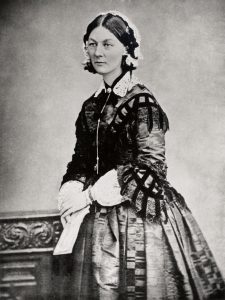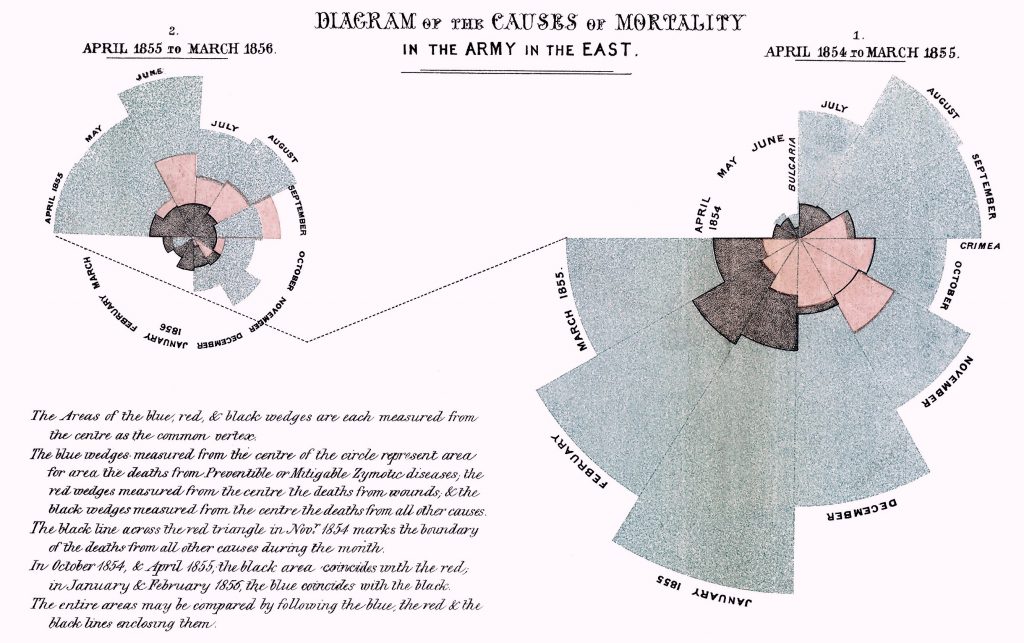From the Archives: Florence Nightingale Does the Math
I just finished writing a review of a book that uses infographics, and only infographics, to tell a historical story. It’s a fascinating and beautiful work–and I’ll tell you all about it after the initial review comes out in Shelf Awareness for Readers. (I’d say that I’m sorry to be a tease, but that would be a lie. Think of it as a blog post trailer.)
As far as I’m concerned, thinking about infographics means thinking about Florence Nightingale. No, really.
Florence Nightingale is best known for her heroic efforts in the Crimean War(1), where she threw open windows, scrubbed filthy floors and equally filthy men(2), bullied doctors and officers on the spot, fought with the British Army’s military director, and saved lives.
She returned home a heroine. Victorian Britain loved to celebrate a celebrity. Nightingale was the recipient of hundreds of poems extolling the Lady with a Lamp. Opportunists printed her picture on souvenirs of every kind: including pottery figurines, lace mats, prints, and paper bags. If Bobblehead dolls had existed at the time, she’d have been Bobbled for sure.
At first Nightingale tried to keep a low-profile. She even traveled home under the unimaginative pseudonym of Miss Smith. She soon came to realize that she could use her celebrity to effect change. With the help of Queen Victoria, who was one of her biggest fans, she convinced the government to set up a Royal Commission to study the health of the army.
One of the lesser known facts about Nightingale is that she was a STEM girl. As a child she loved organizing data. She catalogued her shell collection with precisely drawn tables and lists. When her parents took her and her sisters on a tour of Europe, she collected population statistics . Later she studied mathematics with a personal tutor–not a normal choice for a young woman at the time. She once claimed that she found the sight of a long column of numbers “perfectly reviving.”
Rather than leaving the question of the army’s health to the Royal Commission, Nightingale analyzed the army data herself, working with leading statistician William Farr and sanitation expert John Sutherland of the Sanitary Commission. She reached the conclusion that 16,000 of the 18,000 deaths in the Crimean War were the result of preventable diseases.
Nightingale knew that her love for the clarity of numerical tables is not shared by all. She decided to present her data in a revolutionary way: statistical graphics. (3) Her “rose diagram”, a variation on the modern pie chart, presented her figures in a dramatic and easily understood form.
She went on to spearhead other reform campaigns, using a combination of statistical analysis and expert advice. She prepared by reading the best information available, collecting her own information if good studies didn’t exist, interviewing experts, and testing her recommended changes before releasing her results. The “Lady with the Lamp” gained a new nickname, “the passionate statistician”.
Florence Nightingale: founder of modern nursing, social reformer, grandmother of the info-graphic.
(1) Publicized by the indefatigable William Howard Russell as part of his outraged news reports on the condition under which British soldiers fought and died in that war.
(2)Or more accurately, caused others to scrub.
(3) Farr thought it was a bad idea: “You complain that your report would be dry. The dryer the better. Statistics should be the dryest of all reading.”







There’s a museum in the basement of St. Thomas Hospital, which is right across the bridge from Westminster Abby. St. Thomas Hospital is where she opened the first real school of nursing. I sort of stumbled across the place, and as a nurse, I felt compelled to see it expecting it to contain a picture or two, a statue. Surprisingly, it was pretty marvelous. There was a class of children being taught about Nightingale by a couple of actors in full costume. In England, her legacy is part of the curriculum one of the museum’s staff told me. Thanks for the article. She really was a hero and because of her, countless lives have been saved by nurses around the world.
I look forward to visiting that museum one day.